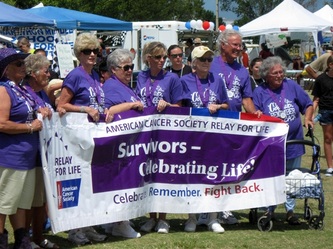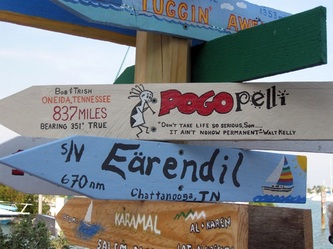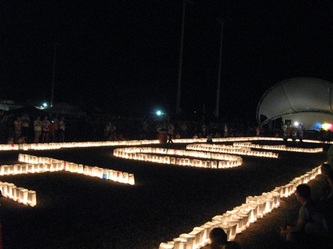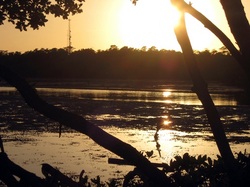
Sunset at Boot Key Harbor
Fernandina? So, what about the Dry Tortugas? Isn’t that where we were headed? Well . . . We started looking at the weather most seriously as March was coming to an end for a run out to this westernmost outpost of the Florida Keys. And as
frequently happens, we could find the weather to get there with no problems, but coming back was not so easy. You see, when the winds shift west, which is a good direction for coming back from the Dry Tortugas, that usually means a front is coming through. Therefore this is not the weather you typically want to travel in, much less anchor in
the very-exposed Marquesas, the only stopping point between Key West and the Dry Tortugas.
With the risk of being stuck out there, and with the temperature and humidity continuing to rise, we decided it was time to turn north. If we are meant to go to the Dry Tortugas, it will happen, but it won’t be this year. We turned our eyes north and began to make our way out of the Keys.
frequently happens, we could find the weather to get there with no problems, but coming back was not so easy. You see, when the winds shift west, which is a good direction for coming back from the Dry Tortugas, that usually means a front is coming through. Therefore this is not the weather you typically want to travel in, much less anchor in
the very-exposed Marquesas, the only stopping point between Key West and the Dry Tortugas.
With the risk of being stuck out there, and with the temperature and humidity continuing to rise, we decided it was time to turn north. If we are meant to go to the Dry Tortugas, it will happen, but it won’t be this year. We turned our eyes north and began to make our way out of the Keys.
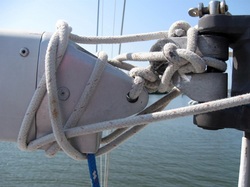
Our boom, loosely attached to mast after our sail.
Traveling Again (or What are those white things for?)
With an eye toward sailing as much as possible for our travels, we looked for traveling weather that had the right winds that would make this possible. But we were also anxious to get started. We had scheduled a bottom cleaning for Orion before leaving Boot Key Harbor, which turned out be a very good thing. The warmer temperatures had accelerated growth exponentially in the last couple weeks of our stay. The diver said that our prop looked like a basketball, and that no underwater surface was untouched. With the growth accumulating that fast, we didn’t want to stick around too much longer, so we took a less than perfect window to leave the harbor early on the morning of Thursday, April 7th. The east wi nds were too much on the nose to sail and when we realized they were not going to moderate or shift (as some earlier forecasts had indicated) until the next day, we were forced to change our plans. Anchoring at Rodriguez Key, which has no protection from the east winds was going to be very rough. So, we decided to stop early the first day and anchor near Channel Five (to get in the lee of Lower Matecumbe Key) in Matecumbe Bight. As we were discussing where to go with Lunar Sea (our traveling companions), fellow cruisers on Symmetry, a catamaran, broke in and recommended this anchorage as a good alternative. Other than the 2 of us, there was only one other boat anchored in this huge anchorage. We used the extra time from our early stopover, to top off our fuel tank and finish preparations for the overnight to take us up the coast.
We weren’t exactly sure how the next day would play out. Dave and Renee suggested some
alternatives of taking the inside route from there or cutting through from Hawk Channel to the ICW at Angelfish Creek. None of these looked appealing to us. The inside route south of
Angelfish Creek is notoriously shallow, and Angelfish Creek (according to BoatUS) would only have enough depth for us at mid-tide. Our best timing to this spot would put us there just before low tide, and with no attractive alternatives for anchoring, since the winds would rule out Rodriguez Key again. Also, we were headed to different destinations. We were heading up the coast as far as the weather would take us. Dave and Renee were headed for Pompano Beach, near Fort Lauderdale. They needed to go slow so that we wouldn’t arrive at the inlet before morning. We weren’t in a hurry, but we were going out for the long haul, expecting a multi-night overnight.
As we headed out the next morning, we tested the winds and decided we would keep going into the night, either in Hawk Channel or out to the ocean at Turtle Rocks through the reef opposite Angelfish Creek. With this decision made, we cut the engine and began sailing on the headsail.
Our speed dropped, but we would still get to the decision point in daylight, and since we were going to travel with Dave and Renee as far as Fort Lauderdale, we were in no hurry. This could work.
With an eye toward sailing as much as possible for our travels, we looked for traveling weather that had the right winds that would make this possible. But we were also anxious to get started. We had scheduled a bottom cleaning for Orion before leaving Boot Key Harbor, which turned out be a very good thing. The warmer temperatures had accelerated growth exponentially in the last couple weeks of our stay. The diver said that our prop looked like a basketball, and that no underwater surface was untouched. With the growth accumulating that fast, we didn’t want to stick around too much longer, so we took a less than perfect window to leave the harbor early on the morning of Thursday, April 7th. The east wi nds were too much on the nose to sail and when we realized they were not going to moderate or shift (as some earlier forecasts had indicated) until the next day, we were forced to change our plans. Anchoring at Rodriguez Key, which has no protection from the east winds was going to be very rough. So, we decided to stop early the first day and anchor near Channel Five (to get in the lee of Lower Matecumbe Key) in Matecumbe Bight. As we were discussing where to go with Lunar Sea (our traveling companions), fellow cruisers on Symmetry, a catamaran, broke in and recommended this anchorage as a good alternative. Other than the 2 of us, there was only one other boat anchored in this huge anchorage. We used the extra time from our early stopover, to top off our fuel tank and finish preparations for the overnight to take us up the coast.
We weren’t exactly sure how the next day would play out. Dave and Renee suggested some
alternatives of taking the inside route from there or cutting through from Hawk Channel to the ICW at Angelfish Creek. None of these looked appealing to us. The inside route south of
Angelfish Creek is notoriously shallow, and Angelfish Creek (according to BoatUS) would only have enough depth for us at mid-tide. Our best timing to this spot would put us there just before low tide, and with no attractive alternatives for anchoring, since the winds would rule out Rodriguez Key again. Also, we were headed to different destinations. We were heading up the coast as far as the weather would take us. Dave and Renee were headed for Pompano Beach, near Fort Lauderdale. They needed to go slow so that we wouldn’t arrive at the inlet before morning. We weren’t in a hurry, but we were going out for the long haul, expecting a multi-night overnight.
As we headed out the next morning, we tested the winds and decided we would keep going into the night, either in Hawk Channel or out to the ocean at Turtle Rocks through the reef opposite Angelfish Creek. With this decision made, we cut the engine and began sailing on the headsail.
Our speed dropped, but we would still get to the decision point in daylight, and since we were going to travel with Dave and Renee as far as Fort Lauderdale, we were in no hurry. This could work.
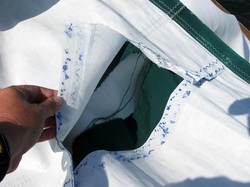
But things weren’t going to go quite as planned. In the middle of a tack mid-afternoon, our headsail got caught on a spreader tip and was torn. It was made worse when it backwinded later on. We then had to furl it to keep it off the spreaders, but this slowed our
progress. As we examined our alternatives for leaving the Keys, the option of staying in Hawk Channel until we got to Key Biscayne was less attractive. There are many unlit daymarks on the
channel, which would make travel at night harrowing. We recommended heading out Turtle Rocks. Since the Gulf Stream was supposed to
be 22 miles off shore, we could stay out of it and travel slowly up the coast to Fort
Lauderdale. As we motored through the reef, Cathy kept a close eye on the water, looking for the brown color that indicated reefs to avoid. The channel was well-marked and the light was good, so it was an easy trip out to the ocean. However, the rough water in the ocean and our speed indicated we had been mislead about the location of the Gulf Stream. We were in it almost as soon as we left the protection of the reef. We tried to sail on our headsail alone, but as the sun started to set, we had concerns about its condition. If it was damaged further during the night, we wouldn’t be able to see it. So, we furled it in and pulled out the main. This would allow us to sail closer to the wind and should allow us to coast along to Fort Lauderdale till morning,
No such luck.
At some point, Cathy awoke with a start. One of the (sizable) beam waves gave Orion a toss and she heard what sounded like a ball bearing rolling around on deck. She popped up to ask Dave
what it was. He gave her a blank look. What noise? She tried to go back to sleep, but then heard it again. This didn’t sound right. She looked through the portlight near where the sound came from. Sure enough, there was something rolling around. She opened the portlight and picked it up. It was a 2 inch long 3/8” diameter pin with a hole through it. This didn’t look good.
In showing it to Dave, he didn’t know where it used to sit in the rigging. We scanned the rigging
with a flashlight, but initially saw nothing amiss. Until, we looked at the boom as it attaches to the mast. Only it wasn’t attached. It was swinging free, held in place by the tension of the main and the rigid vang. We realized our sailing was done for this trip. We started the engine, furled the main, and then Dave went forward (carefully) to lash the boom to the mast for the rest of the trip. Our
problem now was that we couldn’t go slow. With the engine engaged, we would have to run at very low rpm’s to keep us from arriving too early at Fort Lauderdale. This is not good for a diesel engine. So, Dave talked to Lunar Sea and explained our dilemma. We would have to power up and go on up the coast. We wished each other well and said goodbye.
Once we were under engine power, our speed soared. For almost 9 hours, we were traveling around 10 knots, thanks to the Gulf Stream current. We didn’t leave it until we approached Fort Piercearound noon the next day. By that time the seas were glassy calm, and we had the calmest transit of the Fort Pierce inlet ever (well, except for that large cargo ship that we had to avoid on the way in). We were tied up to a mooring at Vero Beach by mid-afternoon. Soon thereafter we had the headsail down and had studied the boom connection to the gooseneck at the mast. This looked like it might be as simple as a cotter pin. In hindsight, we both remembered seeing a cotter pin lying on deck at Marathon, but we couldn’t find where it came from. Now we knew. After we were showered and fed, we fell asleep early, knowing despite the problems it had been a good run and it was good to have some miles behind us.
progress. As we examined our alternatives for leaving the Keys, the option of staying in Hawk Channel until we got to Key Biscayne was less attractive. There are many unlit daymarks on the
channel, which would make travel at night harrowing. We recommended heading out Turtle Rocks. Since the Gulf Stream was supposed to
be 22 miles off shore, we could stay out of it and travel slowly up the coast to Fort
Lauderdale. As we motored through the reef, Cathy kept a close eye on the water, looking for the brown color that indicated reefs to avoid. The channel was well-marked and the light was good, so it was an easy trip out to the ocean. However, the rough water in the ocean and our speed indicated we had been mislead about the location of the Gulf Stream. We were in it almost as soon as we left the protection of the reef. We tried to sail on our headsail alone, but as the sun started to set, we had concerns about its condition. If it was damaged further during the night, we wouldn’t be able to see it. So, we furled it in and pulled out the main. This would allow us to sail closer to the wind and should allow us to coast along to Fort Lauderdale till morning,
No such luck.
At some point, Cathy awoke with a start. One of the (sizable) beam waves gave Orion a toss and she heard what sounded like a ball bearing rolling around on deck. She popped up to ask Dave
what it was. He gave her a blank look. What noise? She tried to go back to sleep, but then heard it again. This didn’t sound right. She looked through the portlight near where the sound came from. Sure enough, there was something rolling around. She opened the portlight and picked it up. It was a 2 inch long 3/8” diameter pin with a hole through it. This didn’t look good.
In showing it to Dave, he didn’t know where it used to sit in the rigging. We scanned the rigging
with a flashlight, but initially saw nothing amiss. Until, we looked at the boom as it attaches to the mast. Only it wasn’t attached. It was swinging free, held in place by the tension of the main and the rigid vang. We realized our sailing was done for this trip. We started the engine, furled the main, and then Dave went forward (carefully) to lash the boom to the mast for the rest of the trip. Our
problem now was that we couldn’t go slow. With the engine engaged, we would have to run at very low rpm’s to keep us from arriving too early at Fort Lauderdale. This is not good for a diesel engine. So, Dave talked to Lunar Sea and explained our dilemma. We would have to power up and go on up the coast. We wished each other well and said goodbye.
Once we were under engine power, our speed soared. For almost 9 hours, we were traveling around 10 knots, thanks to the Gulf Stream current. We didn’t leave it until we approached Fort Piercearound noon the next day. By that time the seas were glassy calm, and we had the calmest transit of the Fort Pierce inlet ever (well, except for that large cargo ship that we had to avoid on the way in). We were tied up to a mooring at Vero Beach by mid-afternoon. Soon thereafter we had the headsail down and had studied the boom connection to the gooseneck at the mast. This looked like it might be as simple as a cotter pin. In hindsight, we both remembered seeing a cotter pin lying on deck at Marathon, but we couldn’t find where it came from. Now we knew. After we were showered and fed, we fell asleep early, knowing despite the problems it had been a good run and it was good to have some miles behind us.
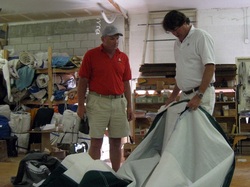
Dave consults with Travis at Mack Sails
Patching Up
One of the reasons we planned to head to Vero Beach was the fact that Tom and Dau (Cathy’s distant cousin) were docked at Fort Pierce nearby. When we called with our tale of woe, they immediately gave us the name of a local sail repair place and offered to take us there. We called and left a message with Mack Sails in Stuart, but since we were arriving on Saturday, any response would have to wait until Monday. In the meantime, Dave exchanged e-mails with Bruce Empey, who was the Neil Pryde representative who designed the headsail. As usual, he was very responsive and had good suggestions of things to consider about the repair.
One of the reasons we planned to head to Vero Beach was the fact that Tom and Dau (Cathy’s distant cousin) were docked at Fort Pierce nearby. When we called with our tale of woe, they immediately gave us the name of a local sail repair place and offered to take us there. We called and left a message with Mack Sails in Stuart, but since we were arriving on Saturday, any response would have to wait until Monday. In the meantime, Dave exchanged e-mails with Bruce Empey, who was the Neil Pryde representative who designed the headsail. As usual, he was very responsive and had good suggestions of things to consider about the repair.
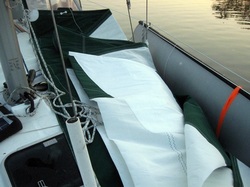
Repaired sail with spreader patch
On Monday, Tom picked us and the sail up and took us down to Stuart. Dave had read more about Mack Sails and learned that they are sailmakers. We called to follow up on our original call, and they graciously agreed to look at our sail, although it was obviously their busy time. (All those boat up north that are about to go into the water want their sails.) When they checked out the sail, they said it was a simple fix, but that they would recommend we add a spreader patch. Since Bruce had already mentioned this, we readily agreed. Amazingly, they said we could pick the sail back up in the afternoon. When we returned, the sail was ready as promised and the price was very reasonable. We were thrilled.
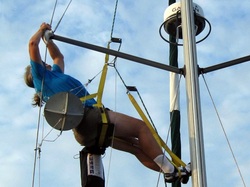
In the calm of early morning the next day, we installed the sail back on its furler. But we weren’t done with this fix. Both Bruce and Travis from Mack Sails had recommended we put spreader boots on the spreader tips to minimize chafe. So, Cathy was up the mast with the new boots from West Marine, along with some rigging tape. This was a little different from other mast adventures, since she had to swing out to each side to get the boots installed. (If this had been required on the first trip up the mast, it would have been a no-go. Now, it’s old hat.) However, their installation was pretty straightforward and it wasn’t long before they were in place and Cathy was back on deck.
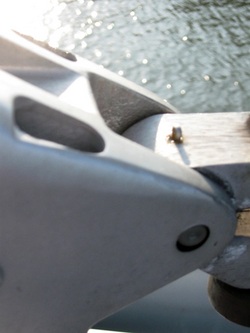
Boom reattached with new cotter pin
Now, we had just one more repair to make. Dave had tried to find the right cotter pin among his supplies on board, but found that a very long, thin one was needed. A fellow cruiser, Frank, on Dream
Weaver, offered his expertise and cotter pin supply to help with the repair, but still we couldn’t find the right one. A trip to the nearby Ace Hardware got us the exact dimensions (2-1/2” x 1/8”), but nothing
that fit. Finally, we made the trip to West Marine to buy a pack of 3. With the right pin in hand, the repair was simple. Dave added some Lanacote to deal with problem of the dissimilar metals and the boom was back in place. We were ready to sail again.
Will It Work?
Our chance to test the repairs came on the next leg of our trip. We planned to hop out at Cape Canaveral and travel north to either St. Augustineor Fernandina Beach. After a day of motoring north to
Cocoa Beachon the ICW, we were positioned to head out the canal the next morning. It was déjà vu all over again. We had tried this in the fall, but were stopped by the canal having been closed. It had re-opened the Saturday before we arrived (we checked). So, we passed through the Christa McAuliffeBridge at 8:30 and arrived at the lock by 9am. In our passage, we were accompanied by another small fishing boat and the Sheriff’s patrol boat, along with some dolphins, a manatee and several pelicans. An unusual assortment of creatures and crafts. After the quick lock-through, we hailed the 2nd bridge and were through to the harbor on our way out the inlet. All of the big ship traffic (cruise ships, gambling ships, cargo ships) were not moving, so we had an easy exit to the ocean.
We motored out the inlet and once we had turned to reach our cruising course, we set both sails and turned off the engine. The winds were on the beam and at a perfect angle for sailing. For the rest of the day, they needed little to no adjustment and the auto-pilot held the course without effort. It looked like Orion’s repairs made her as good as before – or maybe even better. As the sun set, we furled the main sail with the hope that the headsail would carry us through until morning. But the winds didn’t cooperate. The winds shifted behind us, causing the sails to flog in the swells, so
we turned on the motor. We motorsailed until mid-morning, when it became apparent that the headsail wasn’t doing anything. We furled it and arrived at Fernandina Beachmid-afternoon Friday under power, but with renewed confidence in our sails.
Weaver, offered his expertise and cotter pin supply to help with the repair, but still we couldn’t find the right one. A trip to the nearby Ace Hardware got us the exact dimensions (2-1/2” x 1/8”), but nothing
that fit. Finally, we made the trip to West Marine to buy a pack of 3. With the right pin in hand, the repair was simple. Dave added some Lanacote to deal with problem of the dissimilar metals and the boom was back in place. We were ready to sail again.
Will It Work?
Our chance to test the repairs came on the next leg of our trip. We planned to hop out at Cape Canaveral and travel north to either St. Augustineor Fernandina Beach. After a day of motoring north to
Cocoa Beachon the ICW, we were positioned to head out the canal the next morning. It was déjà vu all over again. We had tried this in the fall, but were stopped by the canal having been closed. It had re-opened the Saturday before we arrived (we checked). So, we passed through the Christa McAuliffeBridge at 8:30 and arrived at the lock by 9am. In our passage, we were accompanied by another small fishing boat and the Sheriff’s patrol boat, along with some dolphins, a manatee and several pelicans. An unusual assortment of creatures and crafts. After the quick lock-through, we hailed the 2nd bridge and were through to the harbor on our way out the inlet. All of the big ship traffic (cruise ships, gambling ships, cargo ships) were not moving, so we had an easy exit to the ocean.
We motored out the inlet and once we had turned to reach our cruising course, we set both sails and turned off the engine. The winds were on the beam and at a perfect angle for sailing. For the rest of the day, they needed little to no adjustment and the auto-pilot held the course without effort. It looked like Orion’s repairs made her as good as before – or maybe even better. As the sun set, we furled the main sail with the hope that the headsail would carry us through until morning. But the winds didn’t cooperate. The winds shifted behind us, causing the sails to flog in the swells, so
we turned on the motor. We motorsailed until mid-morning, when it became apparent that the headsail wasn’t doing anything. We furled it and arrived at Fernandina Beachmid-afternoon Friday under power, but with renewed confidence in our sails.
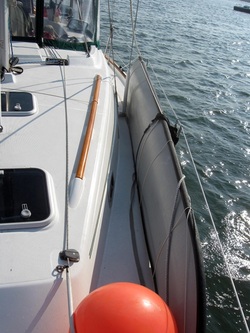
Portaboat stored on deck
Other Boat Stuff
with our departure from Marathon, we finally had to fold up and stow the Porta-boat dinghy. We practiced once in the marina’s project shed, but found it was pretty straightforward. The trick was doing it on Orion’s foredeck. Dave rigged a new
bridle to hoist the dinghy out of the water. Cathy learned the hard way, while winching the boat out of the water, that this one weighs considerably more than our little Zodiac. With the Zodiac still on the foredeck, it was a bit of a challenge to get the seats out, but we did it and Dave managed to lash it on to the lifelines securely for our travels. It took longer than it takes to stow the Zodiac, but we’re still getting the process down. The good news is
that we managed to fold it and stow it as we had hoped. We do have a lot of its parts in our V-berth however. We need to find some ways to reduce the space that it takes up down below.
with our departure from Marathon, we finally had to fold up and stow the Porta-boat dinghy. We practiced once in the marina’s project shed, but found it was pretty straightforward. The trick was doing it on Orion’s foredeck. Dave rigged a new
bridle to hoist the dinghy out of the water. Cathy learned the hard way, while winching the boat out of the water, that this one weighs considerably more than our little Zodiac. With the Zodiac still on the foredeck, it was a bit of a challenge to get the seats out, but we did it and Dave managed to lash it on to the lifelines securely for our travels. It took longer than it takes to stow the Zodiac, but we’re still getting the process down. The good news is
that we managed to fold it and stow it as we had hoped. We do have a lot of its parts in our V-berth however. We need to find some ways to reduce the space that it takes up down below.
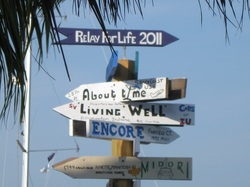
Relay For Life
When we discovered we were going to be in Marathonfor another weekend, we signed up to participate in the Relay for Life on the Cruisers Team, that had been actively fundraising all winter. We looked at the sign-up sheet and discovered that the time slots available were those between midnight and 5am. We chose the midnight to 1am shift. The day of the event dawn hot and humid.
After making an appearance at the noon opening ceremonies, we made some rounds of the various booths and then retreated to find some shade. We were grateful our shift would be out of the sun’s glare. We returned just before the luminaria lighting ceremony at 9pm. The Luminaria are placed in memory or in honor of loved ones with cancer and line the inside perimeter of the track. Then some outline the word HOPE in the middle of the circle. It was an amazing sight. Since we still had time before our shift, we walked up to the movie theater to watch The Adjustment Bureau, with Matt
Damon, and arrived back just in time to pick up our PFD’s (the Cruisers team sign) and start on our hour-long walk. With the music and activity, the hour passed quickly. We were glad we had a chance to help out. The Cruisers team raised over $5000 in support of the American Cancer
Society. Marathon as a whole raised over $100,000. Another record-breaking year, thanks to a very committed group of volunteers.
When we discovered we were going to be in Marathonfor another weekend, we signed up to participate in the Relay for Life on the Cruisers Team, that had been actively fundraising all winter. We looked at the sign-up sheet and discovered that the time slots available were those between midnight and 5am. We chose the midnight to 1am shift. The day of the event dawn hot and humid.
After making an appearance at the noon opening ceremonies, we made some rounds of the various booths and then retreated to find some shade. We were grateful our shift would be out of the sun’s glare. We returned just before the luminaria lighting ceremony at 9pm. The Luminaria are placed in memory or in honor of loved ones with cancer and line the inside perimeter of the track. Then some outline the word HOPE in the middle of the circle. It was an amazing sight. Since we still had time before our shift, we walked up to the movie theater to watch The Adjustment Bureau, with Matt
Damon, and arrived back just in time to pick up our PFD’s (the Cruisers team sign) and start on our hour-long walk. With the music and activity, the hour passed quickly. We were glad we had a chance to help out. The Cruisers team raised over $5000 in support of the American Cancer
Society. Marathon as a whole raised over $100,000. Another record-breaking year, thanks to a very committed group of volunteers.
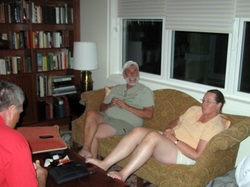
Kindness of Friends (Family)
We had a great time with Tom and Dau during our stay in Vero. We enthusiastically accepted an invitation to dinner on Sunday, that found us at Dau’s mom’s house, where we enjoyed the luxury of a swim in a pool and air-conditioned comfort for
dinner. Wow! The next day, when Tom wasn’t taking us to one or more marine chandleries, we spent some time on Windward at the Harbortown Marina. As a way of doing something in return,
Cathy took a trip up Windward’s mast to run a new spinnaker halyard. After a few false starts, we finally managed to run it through the mast
and out through the hole at deck level. After a dinner at a wonderful little café in downtown Fort Pierce, we headed back to Orion, with lots of thanks and hugs goodbye. We couldn’t have made the repairs to Orion so quickly without their help, and we enjoyed spending time together during
our stay. As always we’re dependent on the kindness of friends, strangers, or (in this case) distant
relatives.
Wind – Too Much or Too Little
It’s all about the wind. There’s either too much or too little. At this point, there is way too much. Since we’ve seen over 30 knots inside the Fernandina mooring field, going offshore is not in the cards until the front passes through. So, we wait for the wind to calm down, but not too much, so we can hop up to Charleston. We’re not alone, since lots of boats here in the harbor are having the same discussion about weather. So, we wait, but it’s been only 9 days since we left Marathon, having traveled 500 miles along the length of Florida, it’s not bad to take a day or two to regroup and get ready for the next run. We can wait for the right wind.
We had a great time with Tom and Dau during our stay in Vero. We enthusiastically accepted an invitation to dinner on Sunday, that found us at Dau’s mom’s house, where we enjoyed the luxury of a swim in a pool and air-conditioned comfort for
dinner. Wow! The next day, when Tom wasn’t taking us to one or more marine chandleries, we spent some time on Windward at the Harbortown Marina. As a way of doing something in return,
Cathy took a trip up Windward’s mast to run a new spinnaker halyard. After a few false starts, we finally managed to run it through the mast
and out through the hole at deck level. After a dinner at a wonderful little café in downtown Fort Pierce, we headed back to Orion, with lots of thanks and hugs goodbye. We couldn’t have made the repairs to Orion so quickly without their help, and we enjoyed spending time together during
our stay. As always we’re dependent on the kindness of friends, strangers, or (in this case) distant
relatives.
Wind – Too Much or Too Little
It’s all about the wind. There’s either too much or too little. At this point, there is way too much. Since we’ve seen over 30 knots inside the Fernandina mooring field, going offshore is not in the cards until the front passes through. So, we wait for the wind to calm down, but not too much, so we can hop up to Charleston. We’re not alone, since lots of boats here in the harbor are having the same discussion about weather. So, we wait, but it’s been only 9 days since we left Marathon, having traveled 500 miles along the length of Florida, it’s not bad to take a day or two to regroup and get ready for the next run. We can wait for the right wind.
